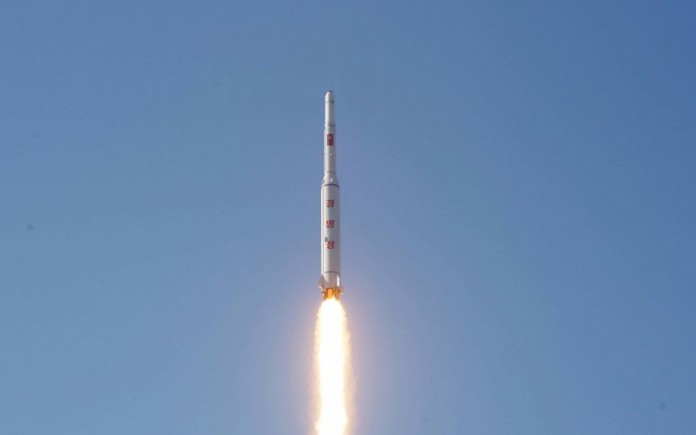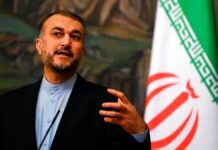
North Korea has taken another step toward achieving its stated goal of being able to send a nuclear weapon to the United States mainland, apparently firing another ballistic missile late Friday night. However, it was not immediately clear whether the missile was an intercontinental one capable of reaching the continental United States.
North Korea appeared to launch the missile just after 11 p.m. local time, South Korea’s joint chiefs of staff said. South Korean President Moon Jae-in convened an emergency national security meeting.
Japanese authorities also reported detecting the launch, with the missile appearing to land within Japan’s exclusive economic zone, the public broadcaster NHK said.
The Hawaii-based U.S. Pacific Command usually confirms missile launches a short time after the South Korean announcement.
If confirmed, this would be unusual as North Korea almost always launches missiles soon after dawn.
Still, a launch had been anticipated. Not only has Kim Jong Un repeatedly said he wants a nuclear-tipped missile that can reach the United States, but American intelligence agencies had in recent days spotted preparations for another test.
The launch took place the day after the anniversary of the conclusion of the Korean War, which ended in an armistice but which Pyongyang claims it won. The day is celebrated in North Korea as “The Day of Victory in the Great Fatherland Liberation War.”
This latest provocation compounds the problem facing the Trump administration and North Korea’s neighbors: how to stop the Kim regime from making progress with its nuclear weapons program.
On Wednesday, the day before the anniversary of the end of the 1950-1953 Korean War, North Korea threatened to launch a preemptive nuclear strike against the United States.
“If enemies misunderstand our strategic status and stick to options of staging a pre-emptive nuclear attack against us, we will launch a nuclear attack on America’s heart as the most relentless punishment without warning or prior notice,” Pak Yong Sik, North Korea’s defense minister, said at a ceremony Wednesday, according to the North’s official Korean Central News Agency.
The test comes barely three weeks after North Korea fired its first missile technically capable of reaching the United States, launched as July 4 dawned in Asia.
That missile, which North Korea called the Hwasong-14 (or Mars-14), was fired from Panghyon, a northwestern part of the country not far from the border with China, and flew to an altitude of 1,741 miles – seven times as high as the International Space Station. It landed 577 miles from its launch site, splashing down in the sea between the Korean peninsula and Japan.
If fired on a trajectory designed to maximize its range, rather than a “lofted” flight path, the missile could have flown 4,970 miles, according to the missile defense project at CSIS. That would put Hawaii and Alaska within reach.
But analysts at the Center for Nonproliferation Studies in California have suggested the missile was capable of getting to New York City.
Jeffrey Lewis, head of the East Asia program at CNS, said the latest apparent ICBM test would have been designed to demonstrate that North Korea could hit more of the mainland United States.
“My guess is that they want to show more range,” Lewis said, adding that North Korea was essentially calling the Pentagon’s bluff. “We basically dared them to do this. We said, ‘It’s not really an ICBM until it can hit Alaska,’ and they’re like ‘okay.'”
The Kim regime has been testing missiles – and making observable technical progress – at a pace that has alarmed analysts and officials alike.
The Pentagon’s Defense Intelligence Agency (DIA) has shaved two full years off the consensus forecast for North Korea’s ICBM program, now estimating that North Korea will be able to field a reliable, nuclear-capable intercontinental ballistic missile as early as next year.
The aggressive testing schedule has already allowed North Korea to validate its basic designs, putting it within a few months of starting industrial production, the officials said.
The July 4 test, which violates United Nations resolutions against North Korea, was met with the usual rounds of international condemnation but the world has not found a way to convince North Korea to stop.
The United States has been leading the charge for more and more sanctions against North Korea, but Russia and China – both veto-wielding permanent members of the U.N. Security Council – have been reluctant to impose painful measures and are instead calling for a “de-escalation plan” to deal with Pyongyang.
The United States won’t know anything about North Korea’s intentions unless it engages the regime seriously and at length, said Sharon Squassoni, head of the proliferation prevention program at the Center for Strategic and International Studies, the Washington-based think-tank.
“Kim Jong Un does seem hell-bent on acquiring the capability to reach the United States with nuclear weapons,” “Although some experts judge this means he will never negotiate, it could also mean that he’s looking for the capability that forces the United States to the table.”
The Trump administration needs to commit resources and real expertise to reshaping peace and security on the Korean peninsula, she said.
Kelsey Davenport, director for nonproliferation policy at the Arms Control Association, agreed that sanctions alone will not change North Korea’s behavior.
“A deployed North Korean ICBM is not inevitable, but it will be if policymakers in Washington keep putting the cart before the horse and demanding Pyongyang meet onerous preconditions to begin talks,” she said.
The Trump administration, like the Obama administration before it, has said that North Korea must agree to freeze its weapons program before talks can begin.
“Washington’s diplomacy deficit is further compounded by the dangerous illusion that sanctions alone will push North Korea to negotiate,” Davenport said, “when the Trump administration and Congress should be focused on signaling support for talks without conditions.”
(c) 2017, The Washington Post · Anna Fifield
{Matzav.com}











